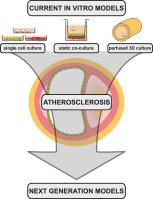在试管中模拟人类动脉粥样硬化病变:我们成功了吗?
IF 4.9
2区 医学
Q1 CARDIAC & CARDIOVASCULAR SYSTEMS
引用次数: 0
摘要
动脉粥样硬化性心血管疾病仍然是全球发病率和死亡率的主要原因。动脉粥样硬化的发生是一个缓慢而漫长的过程,其特点是脂蛋白和免疫细胞在动脉壁上的积聚。动脉粥样硬化已成功地在动物身上建模:然而,在使用这些模型时存在经济、伦理和转化方面的问题。越来越多的人认识到,需要能忠实再现人类动脉粥样硬化关键方面的稳健的人基体外系统。这类系统在可扩展性、可重复性和操纵特定变量的能力方面具有优势,从而有助于加深对疾病机制的理解,加快靶向治疗药物的开发。利用创新的体外平台有望补充传统的动脉粥样硬化动物模型。在本综述中,我们讨论了最近开发的动脉粥样硬化模型的优缺点,并提出了在开发下一代模型时应考虑的想法。本文章由计算机程序翻译,如有差异,请以英文原文为准。

Modeling human atherosclerotic lesions in the test tube: Are we there yet?
Atherosclerotic cardiovascular diseases remain a leading cause of morbidity and mortality worldwide. Atherogenesis is a slow and life-long process characterized by the accumulation of lipoproteins and immune cells within the arterial wall. Atherosclerosis has been successfully modeled in animals: However, there are economic, ethical, and translational concerns when using these models. There is also growing recognition of the need for robust human-based in vitro systems that can faithfully recapitulate key aspects of human atherosclerosis. Such systems may offer advantages in terms of scalability, reproducibility, and ability to manipulate specific variables, thereby facilitating a deeper understanding of disease mechanisms and accelerating the development of targeted therapeutics. Leveraging innovative in vitro platforms holds promise in complementing traditional animal models of atherosclerosis. In the present review, we discuss the advantages and disadvantages of recently developed models of atherosclerosis and propose ideas to be considered when developing future generations of models.
求助全文
通过发布文献求助,成功后即可免费获取论文全文。
去求助
来源期刊

Atherosclerosis
医学-外周血管病
CiteScore
9.80
自引率
3.80%
发文量
1269
审稿时长
36 days
期刊介绍:
Atherosclerosis has an open access mirror journal Atherosclerosis: X, sharing the same aims and scope, editorial team, submission system and rigorous peer review.
Atherosclerosis brings together, from all sources, papers concerned with investigation on atherosclerosis, its risk factors and clinical manifestations. Atherosclerosis covers basic and translational, clinical and population research approaches to arterial and vascular biology and disease, as well as their risk factors including: disturbances of lipid and lipoprotein metabolism, diabetes and hypertension, thrombosis, and inflammation. The Editors are interested in original or review papers dealing with the pathogenesis, environmental, genetic and epigenetic basis, diagnosis or treatment of atherosclerosis and related diseases as well as their risk factors.
 求助内容:
求助内容: 应助结果提醒方式:
应助结果提醒方式:


